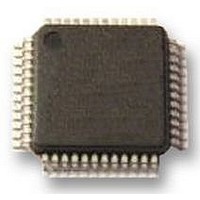DP83848VYB National Semiconductor, DP83848VYB Datasheet - Page 26

DP83848VYB
Manufacturer Part Number
DP83848VYB
Description
TRANSCEIVER, ENET PHY, 10/100, 48LQFP
Manufacturer
National Semiconductor
Datasheet
1.DP83848VYB.pdf
(76 pages)
Specifications of DP83848VYB
Data Rate
100Mbps
No. Of Ports
1
Ethernet Type
IEEE 802.3u
Supply Current
92mA
Supply Voltage Range
3V To 3.6V
Operating Temperature Range
-40°C To +105°C
Digital Ic Case Style
LQFP
No.
RoHS Compliant
Interface Type
MII Serial, RMII
Rohs Compliant
Yes
Lead Free Status / Rohs Status
Not Compliant
Available stocks
Company
Part Number
Manufacturer
Quantity
Price
Company:
Part Number:
DP83848VYB/NOPB
Manufacturer:
NS
Quantity:
570
Company:
Part Number:
DP83848VYB/NOPB
Manufacturer:
Texas Instruments
Quantity:
10 000
www.national.com
4.3.2 Smart Squelch
The smart squelch is responsible for determining when valid
data is present on the differential receive inputs. The
DP83848VYB implements an intelligent receive squelch to
ensure that impulse noise on the receive inputs will not be
mistaken for a valid signal. Smart squelch operation is inde-
pendent of the 10BASE-T operational mode.
The squelch circuitry employs a combination of amplitude and
timing measurements (as specified in the IEEE 802.3 10BSE-
T standard) to determine the validity of data on the twisted
pair inputs (refer to Figure 9).
The signal at the start of a packet is checked by the smart
squelch and any pulses not exceeding the squelch level (ei-
ther positive or negative, depending upon polarity) will be
rejected. Once this first squelch level is overcome correctly,
4.3.3 Collision Detection and SQE
When in Half Duplex, a 10BASE-T collision is detected when
the receive and transmit channels are active simultaneously.
Collisions are reported by the COL signal on the MII. Colli-
sions are also reported when a jabber condition is detected.
The COL signal remains set for the duration of the collision.
If the PHY is receiving when a collision is detected it is re-
ported immediately (through the COL pin).
When heartbeat is enabled, approximately 1 µs after the
transmission of each packet, a Signal Quality Error (SQE)
signal of approximately 10-bit times is generated to indicate
successful transmission. SQE is reported as a pulse on the
COL signal of the MII.
The SQE test is inhibited when the PHY is set in full duplex
mode. SQE can also be inhibited by setting the
HEARTBEAT_DIS bit in the 10BTSCR register.
4.3.4 Carrier Sense
Carrier Sense (CRS) may be asserted due to receive activity
once valid data is detected via the squelch function.
For 10 Mb/s Half Duplex operation, CRS is asserted during
either packet transmission or reception.
For 10 Mb/s Full Duplex operation, CRS is asserted only dur-
ing receive activity.
CRS is deasserted following an end of packet.
FIGURE 9. 10BASE-T Twisted Pair Smart Squelch Operation
26
the opposite squelch level must then be exceeded within 150
ns. Finally the signal must again exceed the original squelch
level within 150 ns to ensure that the input waveform will not
be rejected. This checking procedure results in the loss of
typically three preamble bits at the beginning of each packet.
Only after all these conditions have been satisfied will a con-
trol signal be generated to indicate to the remainder of the
circuitry that valid data is present. At this time, the smart
squelch circuitry is reset.
Valid data is considered to be present until the squelch level
has not been generated for a time longer than 150 ns, indi-
cating the End of Packet. Once good data has been detected,
the squelch levels are reduced to minimize the effect of noise
causing premature End of Packet detection.
4.3.5 Normal Link Pulse Detection/Generation
The link pulse generator produces pulses as defined in the
IEEE 802.3 10BASE-T standard. Each link pulse is nominally
100 ns in duration and transmitted every 16 ms in the absence
of transmit data.
Link pulses are used to check the integrity of the connection
with the remote end. If valid link pulses are not received, the
link detector disables the 10BASE-T twisted pair transmitter,
receiver and collision detection functions.
When the link integrity function is disabled (FORCE_LINK_10
of the 10BTSCR register), a good link is forced and the
10BASE-T transceiver will operate regardless of the pres-
ence of link pulses.
4.3.6 Jabber Function
The jabber function monitors the DP83848VYB's output and
disables the transmitter if it attempts to transmit a packet of
longer than legal size. A jabber timer monitors the transmitter
and disables the transmission if the transmitter is active for
approximately 85 ms.
Once disabled by the Jabber function, the transmitter stays
disabled for the entire time that the ENDEC module's internal
transmit enable is asserted. This signal has to be de-asserted
for approximately 500 ms (the “unjab” time) before the Jabber
function re-enables the transmit outputs.
The Jabber function is only relevant in 10BASE-T mode.
30011710











